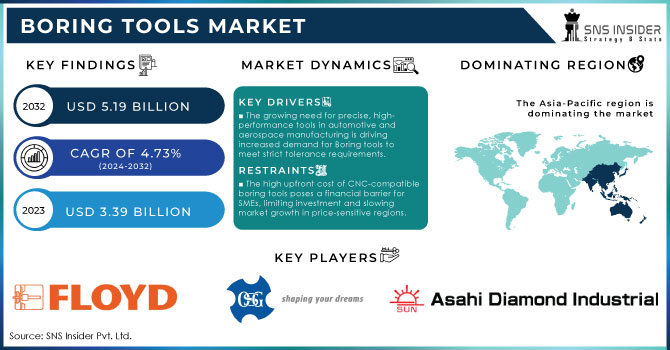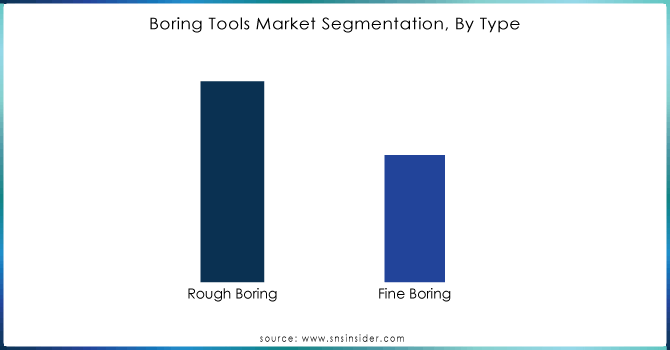Boring Tools Market Report Scope & Overview:

To Get More Information on Boring Tools Market - Request Sample Report
The Boring Tools Market Size was valued at USD 3.39 Billion in 2023 and is expected to reach USD 5.19 Billion by 2032 and grow at a CAGR of 4.73% over the forecast period 2024-2032.
The Boring tool market, integral to drilling and excavation processes, has experienced notable growth due to technological advancements, rising construction activities, and the expanding oil and gas sector. This market encompasses various tools, including rotary drills, augers, and tunnel Boring machines (TBMs). A primary driver of this market expansion is the global increase in infrastructure development. Governments worldwide are investing heavily in transportation networks, including roads, railways, and urban projects. Infrastructure investments in emerging economies have surged by nearly 40% in the past five years. This influx of funding necessitates efficient Boring tools, as successful execution of these projects relies heavily on their capabilities.
Urbanization also plays a crucial role in shaping the Boring tool market. With urban areas experiencing rapid growth and increasing population densities, there is a heightened demand for underground construction to support utilities, drainage systems, and transportation networks like subways. The deployment of TBMs has increased in response, as these machines can excavate tunnels at impressive rates up to 20 meters per day thereby shortening project timelines significantly. The oil and gas sector's recovery has further fueled this demand. Global investments in exploration and production activities surged by 20% last year, with a considerable portion directed towards drilling technologies, highlighting the industry's reliance on advanced Boring tools. Innovations in technology have also enhanced performance metrics; modern TBMs now feature advanced monitoring systems that provide real-time data on.
MARKET DYNAMICS
DRIVERS
- The growing need for precise, high-performance tools in automotive and aerospace manufacturing is driving increased demand for Boring tools to meet strict tolerance requirements.
The automotive and aerospace industries rely heavily on precision machining, where even minor deviations can significantly impact product performance and safety. In both sectors, Boring tools are crucial for producing high-precision components, such as engine parts, gear systems, and hydraulic cylinders, which require accurate hole-making to maintain tight tolerances. In aerospace manufacturing, where weight and balance are critical, Boring tools help ensure that components meet exact specifications, improving fuel efficiency and performance while reducing waste. Similarly, in the automotive industry, precision is necessary to optimize engine efficiency, durability, and emissions control. As these industries continue to evolve, the demand for lightweight materials such as aluminum, titanium, and composites has risen. Boring tools, especially those designed with advanced cutting materials like carbide or diamond coatings, enable manufacturers to machine these materials effectively while maintaining precision. Furthermore, the shift towards electric vehicles (EVs) in the automotive sector requires new types of components and assemblies, further increasing the need for high-performance Boring tools that can handle the unique demands of EV parts production.
Additionally, both industries are integrating automation and digitalization into manufacturing processes, enhancing the demand for CNC (Computer Numerical Control) Boring tools. These machines enable faster production cycles, improved accuracy, and reduced downtime. As a result, the growing complexities and performance demands in automotive and aerospace sectors are major drivers for the increasing adoption of Boring tools, ensuring precision and quality in high-stakes manufacturing environments.
- The expansion of the metalworking industry across sectors like construction, defense, and oil & gas drives demand for high-precision Boring tools, supporting market growth.
The expansion of the metalworking industry, particularly in sectors like construction, defense, and oil & gas, is a significant driver for the growth of the Boring tool market. Metalworking involves the shaping and machining of metal parts for various industrial applications, many of which demand extreme precision and durability. As industries such as construction and defense continue to evolve, they increasingly rely on metal components for building infrastructure, military equipment, and machinery.
The oil & gas sector also demands specialized metal parts for equipment used in exploration and extraction. These industries often require Boring tools for tasks such as enlarging pre-drilled holes or ensuring accurate dimensions, which are critical for safety, performance, and compliance with strict regulations. High-precision tools, including Boring tools, enable manufacturers to meet these stringent requirements while reducing material waste and increasing production efficiency. Global demand for metal components is rising due to rapid urbanization, increasing defense budgets, and growing investments in energy infrastructure. This, in turn, drives the need for high-quality machining tools that can produce parts with tight tolerances. Additionally, advances in metalworking technologies, such as CNC (Computer Numerical Control) machines, have made Boring tools more essential for industries aiming to enhance productivity and reduce downtime. As the metalworking industry expands, the demand for Boring tools is expected to continue its upward trend, supported by ongoing industrialization and technological advancements.
RESTRAIN
- The significant upfront cost of high-performance Boring tools, particularly CNC-compatible systems, can be a financial barrier for small and medium-sized enterprises (SMEs), restricting their ability to invest and hindering market growth in price-sensitive areas.
The high initial investment required for acquiring high-performance Boring tools, particularly CNC-compatible equipment, poses a significant barrier for small and medium-sized enterprises (SMEs) in the manufacturing sector. These advanced machines often come with substantial costs due to their precision engineering, advanced technology, and the materials used in their construction. For SMEs, which typically operate with tighter budgets and lower profit margins compared to larger corporations, this financial burden can be overwhelming. The upfront capital needed not only includes the purchase price of the equipment but also additional expenses for installation, training, and maintenance, which can further strain financial resources.
In price-sensitive regions, where SMEs play a crucial role in the local economy, the inability to invest in high-performance tools can limit their competitiveness. Without access to advanced Boring tools, these businesses may struggle to meet the increasing demand for precision machining in industries such as automotive, aerospace, and construction. This situation can create a cycle of stagnation, where the lack of investment leads to lower productivity and reduced product quality, ultimately affecting profitability and growth potential.
Moreover, the financial risk associated with investing in such equipment can deter SMEs from pursuing necessary upgrades, hindering innovation and technological advancement. As a result, the overall growth of the Boring tool market may be constrained, particularly in regions where SMEs are significant contributors to economic activity. Addressing this challenge is essential to unlock the market’s full potential and promote broader adoption of advanced manufacturing technologies.
KEY SEGMENTATION ANALYSIS
By Type
The fine Boring segment dominated the market share over 58.09% in 2023. The growing need for superior finishing in the manufacturing sector has driven demand for fine Boring tools. These tools offer flexibility for making precise adjustments when finishing holes with tight tolerances. To meet client requirements, companies heavily depend on precision finish Boring tools, which are particularly effective for small-scale projects or when substantial material remains in the hole. The finished Boring technique allows users to create holes of varying diameters using the same tool.

Do You Need any Customization Research on Boring Tools Market - Inquire Now
REGIONAL ANALYSIS
In 2023, Asia-Pacific dominated the market share over 45.06% in 2023. The region’s dominance can be attributed to the significant rise in businesses manufacturing and selling Boring equipment, driven by robust demand from various sectors like automotive, heavy trucks, and manufacturing. Nations such as China, India, and Indonesia are experiencing rapid industrialization, with increasing investments in automobile production and infrastructure. The rising population in these countries further propels demand for automobiles, heavy machinery, and consumer goods, which rely heavily on Boring tools for precision machining and manufacturing processes.
Europe is projected to witness the fastest growth in the Boring tools market, as evidenced by its rapid expansion in 2023. The established automotive manufacturing industry in countries such as France, the United Kingdom, and Germany plays a crucial role in the growth of the region’s market. These nations are home to major automobile manufacturers, as well as key suppliers of components for the automotive industry, which require high-precision Boring tools for production. The rise in demand for electric vehicles (EVs) and advancements in automotive technologies are also pushing manufacturers to adopt more sophisticated machining tools, including Boring systems.

KEY PLAYERS
Some of the major key players of Boring Tools Market
- Advanced Carbide Tool Company, Inc.: (Precision carbide cutting tools)
- Floyd Automatic Tooling Ltd: (Swiss-type turning tools and cutting solutions)
- AMAMCO Tool: (Custom carbide tools, drilling, and reaming tools)
- OSG Corporation: (Taps, end mills, drills, and indexable Boring tools)
- Asahi Diamond Industrial Co., Ltd.: (Diamond and CBN tools for cutting, grinding, and drilling)
- Mitsubishi Heavy Industries Machine Tool Co., Ltd.: (Boring bars, precision cutting tools)
- Allied Machine & Engineering: (Boring systems, drilling, and reaming tools)
- CeramTec: (Ceramic cutting tools and inserts)
- KOMET Deutschland GmbH: (Precision Boring, reaming, and threading tools)
- Sandvik AB: (Indexable tools for Boring, turning, and milling)
- Kennametal Inc.: (Boring tools, inserts, and cutting systems)
- BIG KAISER Precision Tooling Inc.: (Fine Boring heads, tools for milling and turning)
- Walter AG: (Boring tools, drilling, milling, and threading tools)
- ISCAR Ltd.: (Boring bars, cutting inserts, and toolholders)
- Seco Tools AB: (Indexable cutting tools for Boring and turning)
- Ingersoll Cutting Tools: (Boring systems, indexable inserts)
- Sumitomo Electric Carbide, Inc.: (Indexable Boring tools, end mills, inserts)
- NTK Cutting Tools: (Ceramic and carbide Boring tools)
- Tungaloy Corporation: (Boring tools, indexable cutters)
- MAPAL Group (Precision Boring and reaming tools)
RECENT DEVELOPMENT
In 2024: Tungaloy introduced six new sizes of 12xD and 14xD anti-vibration deep Boring bars. These tools feature an integrated dampening system that minimizes vibrations, enhancing performance in deep Boring applications.
In 2023: Sumitomo released a range of high-precision Boring tools tailored for the production of complex aerospace components. These tools offer enhanced durability and performance, significantly increasing productivity in precision engineering.
| Report Attributes | Details |
|---|---|
| Market Size in 2023 | USD 3.39 Billion |
| Market Size by 2032 | USD 5.19 Billion |
| CAGR | CAGR of 4.80% From 2024 to 2032 |
| Base Year | 2023 |
| Forecast Period | 2024-2032 |
| Historical Data | 2020-2022 |
| Report Scope & Coverage | Market Size, Segments Analysis, Competitive Landscape, Regional Analysis, DROC & SWOT Analysis, Forecast Outlook |
| Key Segments | • By Type (Rough Boring and Fine Boring) • By End User (Transportation, General Machinery, Precision Engineering, And Others) |
| Regional Analysis/Coverage | North America (US, Canada, Mexico), Europe (Eastern Europe [Poland, Romania, Hungary, Turkey, Rest of Eastern Europe] Western Europe] Germany, France, UK, Italy, Spain, Netherlands, Switzerland, Austria, Rest of Western Europe]), Asia Pacific (China, India, Japan, South Korea, Vietnam, Singapore, Australia, Rest of Asia Pacific), Middle East & Africa (Middle East [UAE, Egypt, Saudi Arabia, Qatar, Rest of Middle East], Africa [Nigeria, South Africa, Rest of Africa], Latin America (Brazil, Argentina, Colombia, Rest of Latin America) |
| Company Profiles | Advanced Carbide Tool Company, Inc., Floyd Automatic Tooling Ltd, AMAMCO Tool, OSG Corporation, Asahi Diamond Industrial Co., Ltd., Mitsubishi Heavy Industries Machine Tool Co., Ltd., Allied Machine & Engineering, CeramTec, KOMET Deutschland GmbH, Sandvik AB, Kennametal Inc., BIG KAISER Precision Tooling Inc., Walter AG, ISCAR Ltd., Seco Tools AB, Ingersoll Cutting Tools, Sumitomo Electric Carbide, Inc., NTK Cutting Tools, Tungaloy Corporation, MAPAL Group. |
| Key Drivers | • The growing need for precise, high-performance tools in automotive and aerospace manufacturing is driving increased demand for boring tools to meet strict tolerance requirements. • The expansion of the metalworking industry across sectors like construction, defense, and oil & gas drives demand for high-precision boring tools, supporting market growth. |
| RESTRAINTS | •The significant upfront cost of high-performance boring tools, particularly CNC-compatible systems, can be a financial barrier for small and medium-sized enterprises (SMEs), restricting their ability to invest and hindering market growth in price-sensitive areas. |

